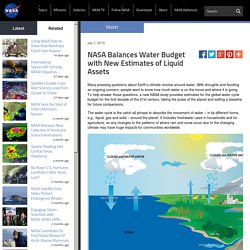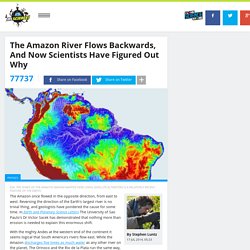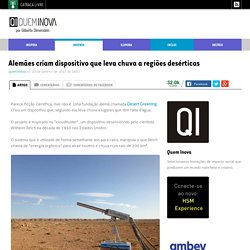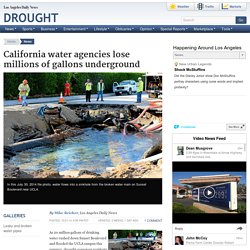

Estimates 'Liquid Assets' of World's Water Budget. Many pressing questions about Earth’s climate revolve around water.

The Amazon River Flows Backwards, And Now Scientists Have Figured Out Why. The Amazon once flowed in the opposite direction, from east to west.

Reversing the direction of the Earth's largest river is no trivial thing, and geologists have pondered the cause for some time. In Earth and Planetary Science Letters The University of Sao Paulo's Dr Victor Sacek has demonstrated that nothing more than erosion is needed to explain this enormous shift. With the mighty Andes at the western end of the continent it seems logical that South America's rivers flow east. While the Amazon discharges five times as much water as any other river on the planet, The Orinoco and the Rio de la Plata run the same way, each dwarfing any river in North America or Europe in the process. However, until 10 million years ago, most of what is now the Amazon basin was drained by a river that flowed west into a giant lake that lay at the feet of the northern Andes.
Alarm bells toll for human civilization as world's 12th largest mega-city to run out of water in just 60 days. Alemães criam dispositivo que leva chuva a regiões desérticas. Parece ficção científica, mas não é.

Uma fundação alemã chamada Desert Greening criou um dispositivo que, segundo ela, leva chuva a lugares que têm falta d'água. O projeto é inspirado no "cloudbuster", um dispositivo desenvolvido pelo cientista Wilhelm Reich na década de 1950 nos Estados Unidos. O sistema que é utilizado de forma semelhante aos para-raios, manipula o que Reich chama de "energia orgônica" para atrair nuvens e chuva num raio de 200 km². A partir desse conhecimento, o Desert Greening testou um dispositivo semelhante em uma região no interior da Argélia, na África, país muito quente e bastante árido. A tecnologia está sendo aplicada no país desde 2005.
Un océan gigantesque à 640 km sous la surface de la Terre. Des scientifiques travaillant à l’université Northwestern , aux Etats-Unis, ont apporté les preuves qu’il existait une immense quantité d’eau sous terre.

Ce réservoir est emprisonné dans une cavité composée d’une roche sous haute pression nommée ringwoodite . Grâce à cette découverte, les chercheurs espèrent expliquer comment les océans se sont formés sur notre planète. L’équipe, dirigée par le minéralogiste Steven Jacobsen , a utilisé un ensemble de 2000 sismographes pour étudier la façon dont les ondes sismiques générées par les tremblements de terre bougeaient à travers l’intérieur de la Terre. La vitesse de ces vagues a changé en fonction des roches à travers lesquelles elles passent, et la ringwoodite mouillée a un effet particulier sur ces ondes. Et si l’eau sur Terre provenait d’un gigantesque réservoir souterrain ? C’est en tout cas ce que pense l’équipe de chercheurs, après avoir découvert cet océan. Le parcours des ondes sismiques révèle la présence d’eau. Massive Ocean Discovered Towards The Earths Core! A reservoir of water three times the volume of all the oceans has been discovered deep beneath the Earth’s surface.

Scientists discover an ocean 400 miles beneath our feet that could fill our oceans three times over. After decades of theorizing and searching, scientists are reporting that they’ve finally found a massive reservoir of water in the Earth’s mantle — a reservoir so vast that could fill the Earth’s oceans three times over.

This discovery suggests that Earth’s surface water actually came from within, as part of a “whole-Earth water cycle,” rather than the prevailing theory of icy comets striking Earth billions of years ago. As always, the more we understand about how the Earth formed, and how its multitude of interior layers continue to function, the more accurately we can predict the future. Weather, sea levels, climate change — these are all closely linked to the tectonic activity that endlessly churns away beneath our feet. Scientists discover an ocean 400 miles beneath our feet that could fill our oceans three times over.
Water Scarcity. Filtration Systems - LIFESAVER systems. Earth’s Disappearing Groundwater : Earth Matters : Blogs. California water agencies lose millions of gallons underground. LADWP: 36.1 million gallons Annual cost: $32 million Fontana (Inland): 1.9 million gallons Annual cost: $822,000 Long Beach: 1.8 million gallons Annual cost: $1.7 million City of Pasadena: 1.5 million gallons.

Masaru emoto. In all of these experiments, distilled water for hospital usage produced by the same company was used.

Since it is distilled twice, it can be said that it is pure water. The result was that we always observed beautiful crystals after giving good words, playing good music, and showing, playing, or offering pure prayer to water. On the other hand, we observed disfigured crystals in the opposite situation. Droughts In California, US Southwest Help Drain 17 Trillion Gallons Of Water From Colorado River Basin In Last Decade. The Colorado River basin has lost 17 trillion gallons of water in the past decade due to drought and ever-rising demand, according to data gathered from NASA satellites.

The disappearance threatens to jeopardize the long-term water supplies of the seven U.S. states and parts of Mexico served by the basin, researchers said. The study, released Thursday by NASA and the University of California at Irvine, is the first to quantify how much groundwater people in the Southwest are using during the region’s current drought, the Associated Press reported. “This is a lot of water to lose. We thought that the picture could be pretty bad, but this was shocking,” Stephanie Castle, the study’s lead author and a water resource specialist at UC Irvine, said in a statement.